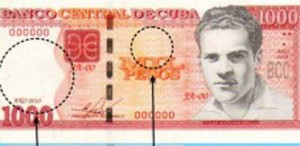Cuba Issues New Bills in Preparation for Monetary Unification

HAVANA TIMES — This Cuban government announced Wednesday that it would issue 200, 500 and 1,000-peso (CUP) notes and that these would be put into circulation on February 1 this year in preparation for the country’s imminent monetary unification process.
The Central Bank of Cuba (BCC) issued a communiqué explaining the decision by referring to the wider use of the CUP at what were hard-currency only (CUC) stores over the past few months, something which has increased the demand for larger denominations of the currency.
The current exchange rate for Cuban pesos (CUP) is just over 20 to the US dollar and 25 to the Cuban Convertible Peso or CUC.
“The Central Bank of Cuba has decided to gradually issue new Cuban peso (CUP) notes with a view to facilitating these transactions,” states the official communiqué, published this Wednesday by Granma and other State newspapers.
The measure implemented by the BCC is backed by Resolution No. 4 of January 15, 2015, published this Thursday in a special issue of the Official Gazette.
Frank Pais, Agramonte and Mella
The new bills will bear the likeness of Cuban revolutionary martyr Frank Pais (200 CUP), the independence hero Ignacio Agramonte (500 CUP) and the communist student leader Julio Antonio Mella (1,000 CUP). All will have a watermark with an image of revolutionary Celia Sanchez Manduley.
The new notes will also be fitted with a holographic strip bearing the value of the bill and the acronym “BCC”, as well as color bands throughout the surface, designed as an anti-counterfeiting measure.
The new 1,000 CUP note will bear the image of student activist Julio Antonio Mella
As of February 1, the new bills will be gradually put into circulation through Cuba’s Metropolitan Bank, the Banco Popular de Ahorro (“Popular Savings Bank”), the Banco de Credito y Comercio (“Credit and Trade Bank”) and currency exchange locales.
The BCC plans on following a work schedule to distribute the bills and will prepare the conditions for the new monetary system using personnel who deal directly with the public at stores and banking institutions.
The characteristics of the new bills will be outlined in signs that will be posted at all banking institutions and retail stores. Bills currently in circulation will be used in conjunction with the new notes and retain their validity.
This is the most important step taken by the Cuban government towards the country’s monetary unification, announced last year.
Cuban Convertible Peso Still in Circulation
For the time being, the CUC (Cuban Convertible Pesos) will continue to circulate, with a value of 25 CUP at the current exchange rate.
News of the measure was accompanied by an interview with Mayobre Lence and Ariel Torres Collazo, BCC Vice-Chair and Issuing and Value Director, respectively, and Barbara Soto Sanchez, commercial manager of the Cuban corporation CIMEX, who touched on the details and scope of the decision.
These officials explained that, over the past few months, the use of the CUP at hard-currency stores has become more widespread. There, the prices are determined on the basis of the exchange rate operative at exchange locales. This situation means that greater quantities of money are handled by individuals and stores on a daily basis.
“The circulation of large-denomation notes will help reduce this problem little by little. To make large payments, people will be able to use these notes,” Mayobre Lence said.
Large Volumes of Money
One of the main difficulties faced today owing to the circulation of the two currencies is that most sales at State stores are paid for using 20 and 50-peso notes. As such, for the purchase of household appliances and furniture (which represent 17 % of incomes at stores run by the CIMEX corporation), customers must carry large quantities of money under conditions that aren’t always optimal.
“In addition, store clerks have to work more to register these large sums of money and, as transactions slow down, the stores’ income decreases, with customers who leave without making a purchase, unwilling to wait in the long lines,” the CIMEX representative explained.
In addition, there have been problems with the registers, too small for such large quantities of money, as only large shopping centers have strong boxes capable of holding large volumes of cash.
With this measure, experts predict a reduced waiting time, less daily withdrawals from safes and general improvement in services.
Government authorities informed the population that the bills will not be available at all bank branches at first, as the distribution of the new notes will be gradual. Havana, the provincial capitals and some municipalities around the country will be prioritized, in dependence on the volume of transactions there.
